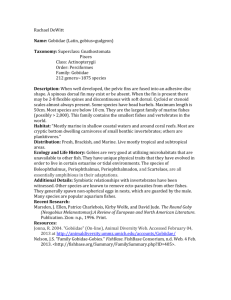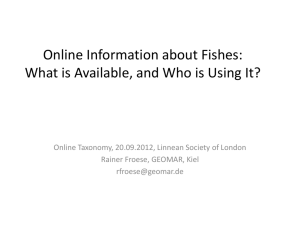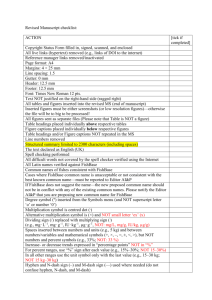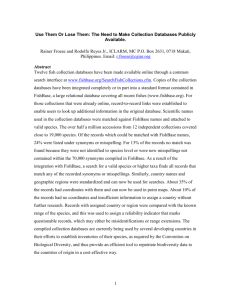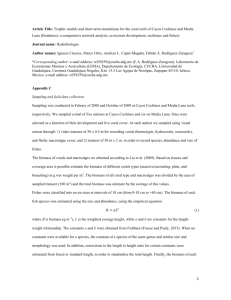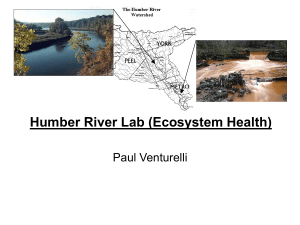ICES STATUTORY MEETING 1993 C.M. 1993/L:6 Session T
advertisement
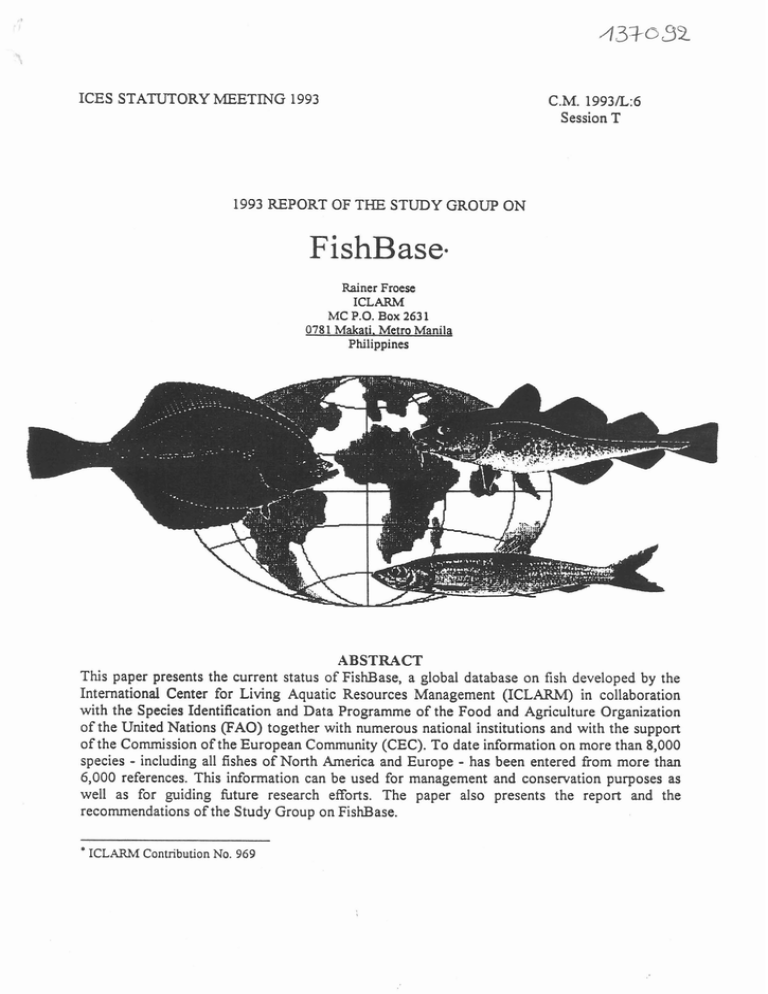
ICES STATUTORY MEETING 1993 C.M. 1993/L:6 Session T 1993 REPORT OF THE STUDY GROUP ON Rainer Froese ICLARM MC P.O.Box 263 1 078 1 Makati. Metro Manila Philippines ABSTRACT This paper presents the current status of FishBase, a global database on fish developed by the International Center for Living Aquatic Resources Management (ICLARM) in collaboration with the Species Identification and Data Programme of the Food and Agriculture Organization of the United Nations (FAO) together with numerous national institutions and with the support of the Commission of the European Community (CEC). To date information on more than 8,000 species - including all fishes of North America and Europe - has been entered from more than 6,000 references. This information can be used for management and conservation purposes as well as for guiding hture research efforts. The paper also presents the report and the recommendations of the Study Group on FishBase. ICLARM Contribution No. 969 Introduction The International Center for Living Aquatic Resources Management (ICLARM) in collaboration with the Species Identification and Data Programme of the Food and Agriculture Organization of the United Nations (FAO) together with numerous national institutions and with the support of the Commission of the European Community (CEC) is developing a global database (FishBase) to summarize key biological information on fish (Agustin et al. 1992; Capuli and Froese 1992; Froese 1990, 1993; Froese et al. 1992; Palomares and Pauly 1992a, 1992b; Palomares et al. 1991; Pauly and Froese 1991a, 1991b, 1992; Pauly et al. 1993). ICES has established the Study Group on FishBase with the following terms of reference: a) to identify more suitable data sets for inclusion in FishBase; b) to collaborate with relevant Working Groups to produce more species synopses for the ICES area; and c) to prepare a presentation of FishBase at the 1993 Theme Session on "Computers in Fisheries Research". Status of FishBase The status of FishBase as of August 1993 is shown in Fig. 1. Information on more than 8,000 species including all fishes of North America and Europe (about 2,000) has been entered from more than 6,000 references. As a result of the efforts of the FishBase Project staff and its collaborators FishBase already contains the following outstanding collections: - - - The largest collection of population dynamics data (growth parameters, natural mortality, length-weight relationships, maximum ages and sizes); The largest collection of ecological data (prey, predators, competitors, diet composition, food consumption); The largest available collection of electrophoretic data; The largest collection of common names (by country and language); The largest collection of genera of recent fishes (Eschmeyer 1990); The largest collection of data on fish metabolism (Thurston and Gehrke 1991); The largest collection of data on larval dynamics (Houde and Zastrow 1992); The largest collection of data on introduced fishes (Welcomme 1988). Several other collections will probably reach this status in the course of the next year, e.g. collections of data on morphology, reproduction, occurrence, swimming speed, and proximate analysis. FishBase Products A demo disk and the FishBase Manual are available from the FishBase Project. A number of other FishBase products are also available on request: - - - Data Collection Forms for contributing information; Summary of available information and references used for a given species (short synopsis); List of references used in FishBase from a given author; Synopsis of all information in FishBase on a given species (h11 synopsis); All species of a given family with basic information and references used; List of species with a given common name; List of all fishes used for aquaculture in phylogenetic order with reference; List of all dangerous fishes; All fishes in FishBase in phylogenetic order; List of fishes for a given FAO statistical area; List of all fish diseases contained in FishBase; Digitized fish pictures as .PCX or .CUT files; - For a given countrv: Checklist of fishes with basic information and common name; Checklist of freshwater fishes; Checklist of marine fishes; Checklist of introduced fishes; Checklist of threatened fishes; Checklist of aquarium fishes; Checklist of fishes used in aquaculture; Checklist of dangerous fishes; Checklist of game fishes. These products are sent Free of cost to requesting parties. Recipients have to be aware that most of the available information has not yet been checked for correctness. Rather they themselves are expected to share any corrections, comments and criticism with the FishBase staff The full FishBase software package with pictures requires about 100 megabytes of space on the harddisk of an IBM compatible computer and has at this stage only been given to close collaborators of the project. As of August 1993 a preliminary version of FishBase has been installed in the following institutions: ICLARM Headquarters, Manila, Philippines; CEC Headquarters, Brussels, Belgium; FAO Headquarters, Rome, Italy; Zoologisches Institut und Museum, Universit2t Hamburg, Hamburg, Germany; Alfred-Wegner Institut f i r Polar- und Meeresforschung, Bremerhaven, Germany; Marine Science Institute, University of the Philippines, Quezon City, Philippines; Institute of Marine Biology and Oceanography, Freetown, Sierra Leone; Instituto de Investiga~iioPesqueira, Maputo, Moqambique; Department of Fisheries, Domasi, Malawi; Department of Land and Natural Resources, Hawaii; Programa de Ecologia, Pesquerias y Oceanografia del Golfo de Mdxico, Campeche, Mexico; CANCOM Fisheries Resources and Management Program, Belize; Ministry of Agriculture, Land and Marine Resources, Fisheries Division, Trinidad and Tobago; Universidad Nacional Mayor La Molina, Lima, Peru; Ecole Nationale Superieure Agronomique de Toulouse, Toulouse, France; M u s h National de 1'Histoire Naturelle, Paris, France; M u s k Royale de I'Afrique Centrale, Temren, Belgium; Institute of Aquatic Biology, Accra. Ghana. ICES Stocks in FishBase So far, four of the 160 stocks monitored by ICES have been included in FishBase: the Baltic flounder (Froese and Friess 1992), the spring-spawning herring of the western Baltic (Froese and Rechlin 1992), and the cod stocks of the western and the middle Baltic, respectively (Weber and Froese 1993). In all cases key information was extracted from scientific publications and filled into Data Collection Forms provided by the FishBase project. The forms were sent to ICLARM where the data were keyed into the computer. The resulting printouts were then checked for correctness. This process is requested by the FishBase Project in order to secure the integrity of the database and contributing authors found it reasonably comfortable and reliable. An analysis of the references used in the three synopses shows a high percentage of nonEnglish and non peer-reviewed literature, both of which are usually difficult to access. The authors concluded that the Data Collection Forms provided by the FiskBase Project were an appropriate tool to capture such information and that the printed synopses were an acceptable framework to make the information available with a standardized English interface. Since the printout from the database is an automatic procedure, it is particularly easy to correct and add information. Once the accumulated information reflects the current knowledge on a stock it can be used to identify research gaps and to avoid unnecessary duplication of research. For example, 5 references with length-weight relationships and 8 references with growth parameters for the cod of the western Baltic indicate that there is little need to redo these studies. On the other hand there are only two records on predators (cannibalism on juveniles; herring feeding on cod eggs). It can be assumed that, e.g., turbot, mackerel, and whiting also feed on juvenile cods. Such information is relevant for ecological models such as ECOPATH (Christensen and Pauly 1992), which help to understand the interactions of a stock with the other major groups in a given ecosystem. It might therefore be worthwhile to research the contribution ofjuvenile cods to the diet of these and other species. Future Development of FishBase FishBase's main target group are fisheries managers and researchers. In order to quickly cover all fishes important to this group, FishBase during its start-up phase used recent summary publications such as Nelson's Fishes of the World (Nelson 1984), Check-list of the Fishes of the North-eastem Atlantic and of the Mediterranean (CLOFNAM, Hureau and Monod, 1979), and Common and Scientific Names of Fishes from the United States and Canada (Robins et al. 1991) as a source of scientific names. This did not satisfy the fish taxonomists who want Fishbase to use and cite the original literature rather than secondary sources. - - In view of this criticism, the FishBase Project plans to firther develop FishBase along four lines. Firstly, recent revisions of families and genera will be the main source to gradually include all fishes with basic information (nomenclature, main characters, distributional range). This will ensure that the taxonomic information is up to date according to the world experts on the respective groups. This task will be greatly facilitated by a cooperation with W. N. Eschrneyer of the California Academy of Science who is working on a complete catalog of recent fishes (names and synonyms) and who will make his respective database available to FishBase. Secondly, checklists for countries and areas (e.g., Daget et al. 1991, Wheeler 1992, Robins et al. 1991) are the main source used to assign species to countries. This task is largely completed for the ICES area and the resulting checklists need verification by the national experts. For other countries, priority is given to those who actively collaborate with the FishBase Project such as Australia, Bangladesh, Ghana, Hawaii, Malawi, Malaysia, Mexico, Peru, the Philippines, and Vietnam. Thirdly, FishBase continues to include - and thus make available - databases developed by others. An example is the database on World Record Game Fishes which the project recently received from the International Game Fish Association in Fort Lauderdale, USA. The database is very usehl in that it contains occurrence records and maximum sizes for a wide variety of species. Fourthly, FishBase staff continues to scan the scientific literature to continuously update the contents of the existing tables. Special efforts are undenvay to open up two bodies of literature which, to a large extent, have not been accessible outside their respective countries, namely Japan and the States of the former USSR. It is planned to make FishBase available on CD-ROM for nominal costs (95 US$) to fisheries' institutions worldwide with special emphasis on developing countries, who will be supported in purchasing the necessary hardware and will receive training on how to use FishBase and related analytical tools. Distribution is planned to start in late 1994. Conservation of fish biodiversity The maintenance of species biodiversity has been put on the global agenda by the United Nations Conference on Environment and Development (UNCED) in Rio de Janeiro in 1992. ICES must be prepared to give advice not only on the management of the 160 commercial stocks but also on how to maintain biodiversity of aquatic species in its area of responsibility which includes more than 800 species of marine fishes alone, 12 of which.-are regarded to be threatened (TUCN 1990). FishBase aims to facilitate the task of conserving fish biodiversity by a threefold approach: i) by compiling all available key information (see above) on these species, ii) by compiling occurrence and abundance data from a wide variety of sources (museum records, research vessel surveys, national angling records, tagging experiments, scientific literature, etc.), and iii) by reporting their status of threat. Once the occurrence and abundance records reach a representative level, FishBase itself can be used to determine the status of threat by combining trends in distribution and abundance with a set of biological characters such as environmental tolerance, fecundity, longevity, and age at first maturity. Collaborators While the FishBase staff over the past three years has developed the foundations of a global information system on fishes, the task of checking, improving and updating the information for their respective areas depends on the national and regional experts. It has to be a collaborative exercise for the FishBase concept to succeed . To date, more than 63 colleagues from 18 countries have actively provided databases or compilations or have helped in checking information. Their name is attached to every record they contributed and their efforts are acknowledged in the respective species synopses. They are also entitled to a free copy of FishBase once it is available. Report and recommendations of the Study Group Due to other commitments of its members, the Study Group - which was to work by correspondence - had little interactions during the reporting period. Nevertheless the Study Group followed up on its terms of reference as follows: Data sets with occurrence records were obtained from the California Academy of a) Science and from the International Game Fish Association. A data set on allele frequencies of fishes turned out to be not available. Two synopses on the cod of the western and the middle Baltic, respectively, were b) completed, thus bringing the total number of ICES stocks covered to four (see above). The present paper is also copied to the Theme Session on "Computers in Fisheries c) Research" where FishBase will be presented. On the basis of the four synopses the Study Group is of the opinion that FishBase is an appropriate tool to compile key information on ICES stocks and to make this information available to the ICES community. The Study Group recommends to the ICES secretariat to 1) have a preliminary copy of FishBase installed at ICES headquarters to gain hands-on experience with the software; 2) explore linkages between FishBase and other ICES databases; 3) consider options to make key information contained in ICES papers available through FishBase; 4) consider options to complete and update biological information on the ICES stocks in FishBase. Acknowledgments FishBase is hnded mainly by the Environment and Development program of the Commission of the European Community, Project No. B7-5040192114. I take this opportunity to thank the FishBase project staff at ICLARM, i.e., Dr. M.L. Palomares, Ms. Susan Luna, Ms. Cris Binohlan, Ms. h i Torres, Ms. Liza Agustin, MS Pasky Sa-a, Ms. Tess Cruz, Mr. Robbie Cada, and Mr. Rudi Reyes. Also I like to thank the outposted FishBase staff, Ms. Mamaa Entsuah Mensa, Institute for Aquatic Biology, Accra, Ghana, and Dr. Jaime Mendo, University of La Molina, Lima, Peru. I want to acknowledge the continuous inspiration and contribution provided by Dr. Daniel Pauly, ICLARM. Finally I would like to acknowledge again the vision of those colleagues who contributed their valuable databases for distribution through FISHBASE. References Agustin, L.Q., R. Froese, A.E. Eknath and R.S.V. Pullin. 1993. Documentation of genetic resources for aquaculture the role of FishBase, p. 63-68 in D. Penman, N. Roongrati and B. McAndrew (eds.) International Workshop on Genetics in Aquaculture and Fisheries Management. ASEAN-EEC Aquaculture Development and Coordination Programme, Bangkok, Thailand. - Capuli, E.E. and R. Froese. 1992. A preliminttry checklist of Philippine fishes produced with FishBase, a global biological database on fishes. Presented at the 2nd National Symposium in Marine Science, 5-7 November 1992, Mindanao State University, Tawi-tawi, Philippines, 25 p. Christensen, V. and D. Pauly. 1992. A guide to the ECOPATH I1 software system (version 2.1). ICLARM software 6, 72 p. International Center for Living Aquatic Resources Management, Manila, Philippines. Daget, J. J.-P. Gosse, G.G. Teugels and D.F.E. Thys van den Audenaerde. 1991. Check-list of the freshwater fishes of Africa. Volume IV. ISNB Brussels, M RAC, Tervuren, ORSTOM, Paris. 740 p. Eschmeyer, W.N. 1990. Catalog of the Genera of Recent Fishes. California Academy of Sciences, San Francisco: 697 p. Froese, R. 1990. FISHBASE: an information system to support fisheries and aquaculture research. Fishbyte 8(3):21-24 Froese. R. 1993. 1993 Study Group Report on FishBase. ICES C.M. 1993/L:6 Froese, R. and C.C. Friess. 1992. Synopsis of biological data on Platichthys]lesus (L.), ICES Sub-division 24, using the FISHBASE format. ICES C.M. 1992/J:39 Froese, R. and 0. Rechlin. 1992. Synopsis of biological data on Clupea harengus (L.), ICES assessment units 22 and 24, using the FISHBASE format. ICES C.M. 1992/1:40. Froese, R. M.L.D. Palonures and D. Pauly. 1992. Draft user's manual of FishBase. International Center for Living Aquatic Resources Management (ICLARM) MC P.O. Box 2631, Makati, Metro Manila 0718, Philippines. 56 p. Houde, E.D. and C.E. Zastrow. 1992. Ecosystem- and taxa-specific dynamic and energetic properties of fish larvae assemblages. Contrib. Science, Los Angeles Museum, in press. Hureau, J.C. and Th. Monod (eds.) 1979. Check-list of the fishes of the north-eastern Atlantic and of the Meditemean (CLOFNAM I and 11). United Nations Educational Scientific and Cultural Organization (UNESCO), Paris, France, Vols 1-2, 683 p. IUCN 1990. 1990 IUCN red list of threatened animals. IUCN, Gland, Switzerland and Cambridge, U.K. 288 p. Nelson, J.S. 1984. Fishes of the world. 2nd edition. John Wiley & Sons, Inc. New York. 523 p. Palomares, M.L.D. and D. Pauly. 1992a. Use of FISHBASE for assembling information on the fishes of Cambodia, Laos and Vietnam. Presented at the 3rd Asian Fisheries Forum, 26-30 October 1992, World Trade Center, Singapore. Palomares, M.L.D. and D. Pauly. 1992b. FISHBASE as a worldwide computerized repository of ethnoichthyology or indigenous knowledge on fishes. Presented at the Lnternational Symposium on Indigenous Knowledge (IK) and Sustainable Development, 20-26 September 1992, International Institute for Rural Reconstruction (IIRR), Silang, Cavite, Philippines. Palomares, M.L.D., J. Moreau, P.Reyes-Marchant, R. Froese and D. Pauly. 1991. FISHBASE: une base de donnees sur les poissons. Fishbyte 9(2): 58-61 Pauly, D. and R. Froese. 1991a. FISHBASE: assembling information on fish. Naga, ICLARM Q. 14(4):10-11 Pauly, D. and R. Froese. 1991b. The FISHBASE project, or how scattered information on fish can be assembled and made useful for research and development. EC Fisheries Cooperation Bulletin, December 1991: 6 p. Pauly, D. and R. Froese. 1992. FishBase, base de datos computarizada sobre 10s peces: uso potencial para Americana Latina. Jaina 3(4): 11 13 Pauly, D., M.L.D. Palomares and R. Froese. 1993. Some prose on a database of indigenous knowledge on fish. Indigenous Knowledge & Development Monitor l(1): 26-27 Robins, C.R., R.M. Bailey,Lea and W.B. Scott. 1991. Common and scientific names of fishes from the United States and Canada. Am. Fish. Soc. Spec. Pub. (20): 183 p. Thurston, R.V. and P.C. Gehrke. 1991. Respiratory oxygen requirements of fishes: description of OXYREF, a data file based on test results in the published literature. Presented at the Second International Symposium on Fish Physiology, Fish Toxicology and Water Pollution. Sacrament0 California, September 1990. US Environmental Protection Agency, Environmental Research Laboratory, Athens, Georgia, USA. pag.var. Welcomme, R.L. 1988. International introductions of inland aquatic species. FAO Fish. Tech. Pap., (294): 318 P. Wheeler, A. 1992. A list of common and scientific names of fishes of the British Isles. J. Fish Biol. 41:l-37 - .- Content of FisliBase, August 1993 > 8,000 > 1 1,000 > 35,000 Conunon names > 6,000 0 200 400 600 800 1000 1200 1400 1600 1800 2000 2200 Species
